Tharches of Thay
Territories of Thay - Tharches
The country of Thay is made up of 11 different Tharches (effectively, States) ruled by a Tharchion or Tharchionesse (Governor) and maintained by various bureaucrats and senior officials (sometimes referred to as Thaen).
Each Tharch claims influence from a small number of deities, with most people across the nation revering some mix of Chauntea, Gond, Mystra, and Waukeen. Although, the worship of Mystra is still not supported publicly. There are plenty of hidden or private shrines to the Goddess of Magic if you look hard enough.
Alaor (“Al-LAY-oar”)
Population: 81,500
Leader: Uldroud Harlrammon
Official Military Presence: The Water Fist, Thayan Knights
Commerce: Imports, fishing, local retail
Religious Influences: Gond, Kossuth, Umberlee, Valkur, Istishia
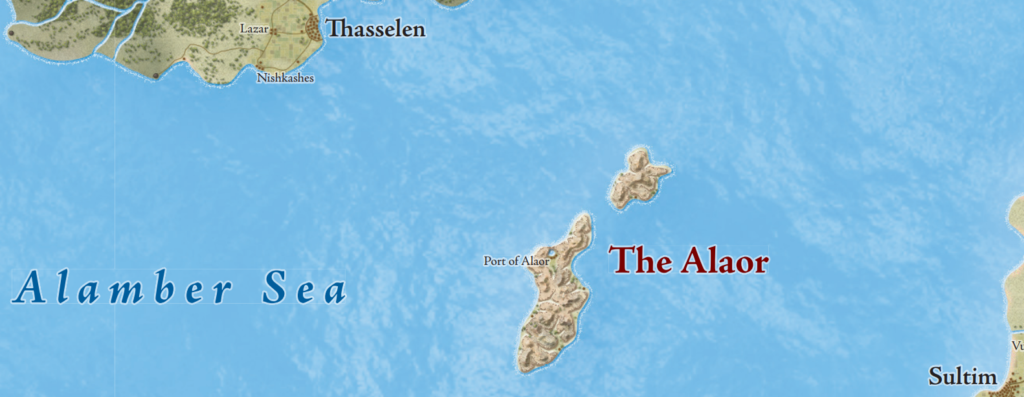
Renewed in recent years as the seat of Thay’s navy, Alaor consists of two islands in the Alamber Sea known as Alaoran and Raeldreth but referred to as “The Alaor” in the collective sense.
Alaoran is the larger island and is home to a shipyard and naval base and has been built over and honeycombed with tunnels and chambers many times over the years. The city above these secret places is where the sailors and their families dwell, and sailmakers and the like work daily.
Thund Greatharbor Anchorage is the breakwater-strengthened main harbor of Alaoran and serves as the seat of daily bustle and moneymaking in the Tharch. It is usually home to a dozen naval ships and four times that many merchant vessels at any one time. The islands have no native tilled land and are entirely reliant on imports for basically every fundamental necessity.
Delhumide (“Dell-hew-MEED”)
Population: 58,000
Leader: Arauntra Taelthoun
Official Military Presence: The Probity Corps, Thayan Knights
Commerce: Agriculture products, subsistence farming
Religious Influences: Chauntea, Gond
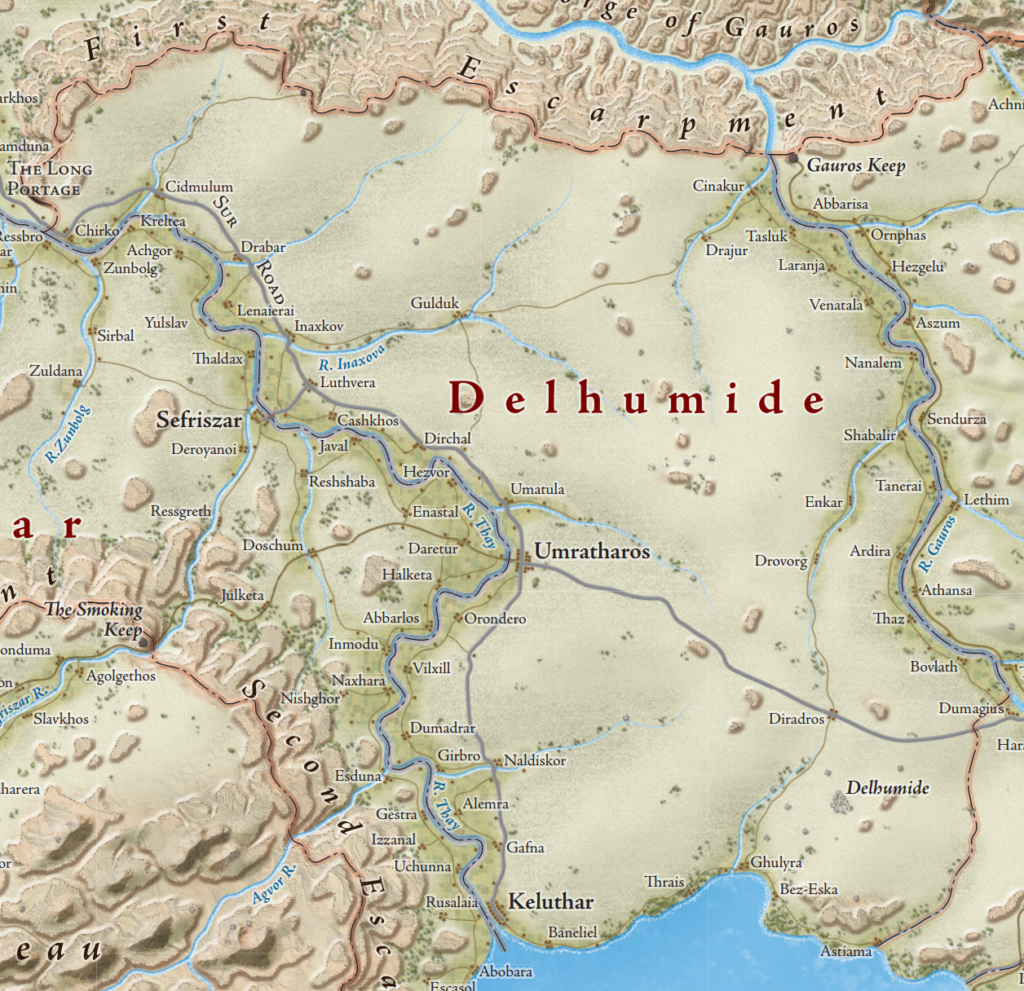
Once the most populous Tharch of Thay, this district was largely reduced to sparsely populated open grazing land after the city of Delhumide was destroyed in Thay’s war for independence from Mulhorand. The city was never rebuilt, and the ruins remain shunned to this day. The crumbling region is roamed by living spells, brigands, “wizard-ghosts,” and all manner of foul monsters.
Since the fall of the city of Delhumide, this Tharch has been governed from the city of Umratharos (“Oom-ra-THAIR-ohs”) which is becoming a city of crafters and innovators, carving wood and casting metal and firing ceramics all under the watchful eye of the Probity Corps, the absolutist authority ensuring peace and order. These enforcers are free from corruption and diligent in their duties out of fear of Szass Tam.
Ranchland is increasingly giving way to farms, and the roadways are constantly improved by crews of skeletons and zombies that toil away after sunset. The population is rising rapidly in recent decades yet is still far less than in olden times.
Eltabbar (“El-TAB-bar”)
Population: 2,699,500
Leader: Aumaund Halakoun
Official Military Presence: The Probity Corps, Thayan Knights
Commerce: Caravan traffic, local retail, agricultural products
Religious Influences: Kossuth, Waukeen
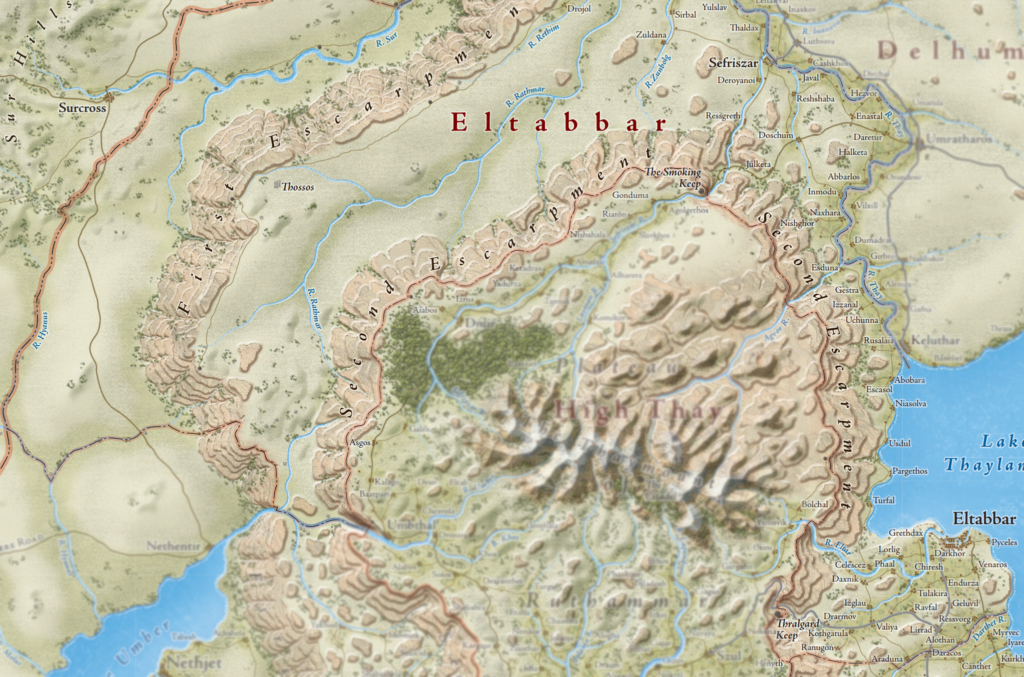
The wealthiest Tharch of Thay, the Tharch known as Eltabbar is home to its current capitol, the city of Eltabbar. This city has been rebuilt and expanded in recent decades and portrays a sense of ever-greater magnificence with each passing year. “Tabar,” as the city is called by most citizens, contains homes for most of Thay’s nobility regardless of their Tharch of origin. Anyone of significant power or influence in Thay, or desires to attain a measure of the same, keeps quarters in Eltabbar.
Always a hotbed of intrigue, The Probity Corps operates openly here and numerous other governmental spies canvas the city. This extends to Daerath Market—the one place in the city where stalls and wagons crowd each other, streets becoming winding alleys between them. Daerath is where shady business can be conducted openly, adventurers may be found and hired, and so on, but sensible citizens know that the tharchion’s spies are more attentive in Daerath than anywhere else.
On one edge of Daerath stands the notorious Pheldanther’s gambling club, in which wagers are placed not just on games played with cards or dice or battle-boards with miniature armies and intricate rules, but on contests between human wrestlers, beasts, and even humans pitted against hungry monsters desiring to eat them. Deadly human-against-human duels have even been wagered on, though spell-duels have been strictly outlawed after several unfortunate fires and explosions.
The infamous Deep Canal is also found here; it is a subterranean sewage circuit that is navigated by narrow barges poled by those who know its labyrinthine ways. It is used as a network of travel routes between the deepest cellars of many city locales. It is said that the corpses of those that ask too many questions or upset the nobles may be found here.
Gauros (“GAR-ohs”)
Population: 28,000
Leader: Haelaedra Kren
Official Military Presence: Thayan Knights
Commerce: Mining, subsistence farming
Religious Influences: Malar, Shar
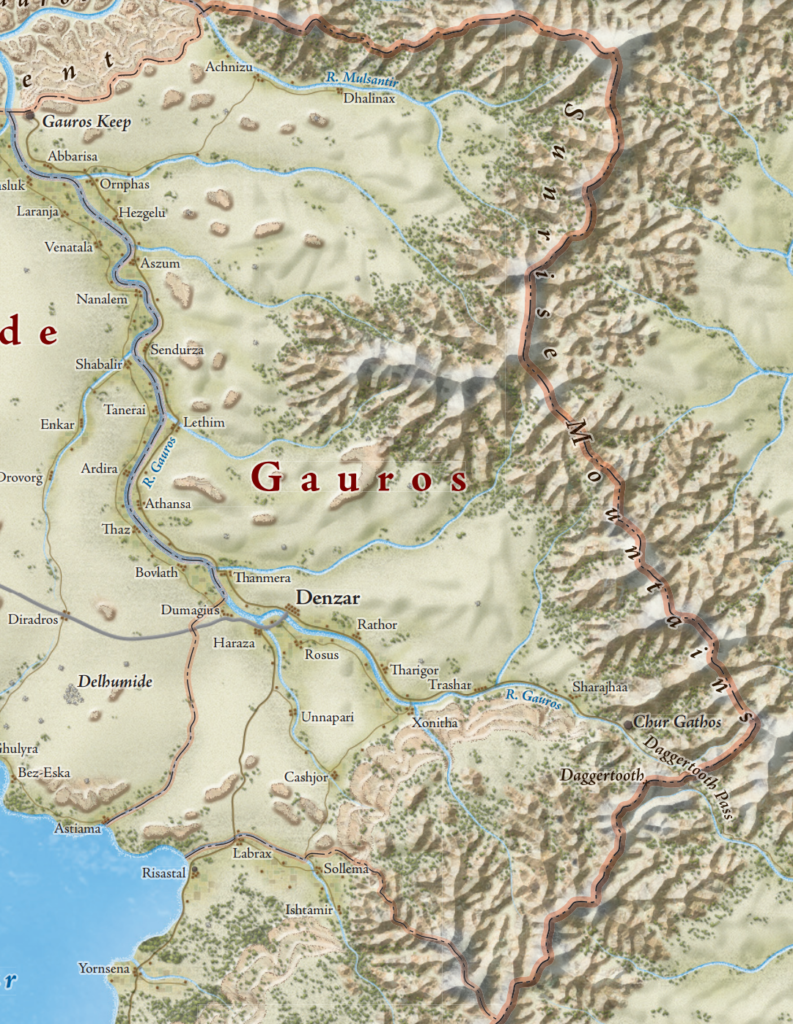
Always one of the wildest, poorest, and most thinly populated Tharches of Thay, Gauros is a border region. The rest of Thay tends to think of it as barren hills and mountains, roaming monsters, and a few dirty, backwoods woodcutters and miners eking out hard livings and dying poor and young. The truth is that while Gauros is the wildest region of Thay, it is also verdant and almost completely unspoiled. The Sunset Mountain range is where the main exports come from in the form of roughly smelted iron and copper.
Nearly all of its citizens are free, and they enjoy plentiful game and bountiful harvest thanks to the region’s abundant natural resources. Still, most are poor but have little need of coin as they pride themselves on being nearly completely self-sustaining. Gauros is a place of pragmatism and living close to the land, with most inhabitants sharing a distaste for the energetic intrigues and politics that most other Thayans hold dear. The strongest desires here are to keep Gauros as it is, not let cities and marching undead and lots of slaves and Red Wizards become numerous and dominant.
There are rumors of a well-hidden subterranean labyrinth beneath the Sunset Mountains that have long been used as a hidden brigand lair. These outlaws, it is said, raid the rest of Thay with great care and precision, taking only what they need and keeping as low of a profile as possible to mitigate the likelihood of hostile response from the Red Wizards. Sometimes referred to as “The Quiet Claws,” these outlaws are said to act to discredit or assassinate any Thayan who seems to have decided that they must be eradicated.
Lapendrar (“Lapen-drarr”)
Population: 1,006,500
Leader: Dathace Yamraharr
Official Military Presence: The Probity Corps; Corps of Thayan Knights
Commerce: Cash crops and agricultural exports, durable fine goods
Religious Influences: Chauntea, Shiallia
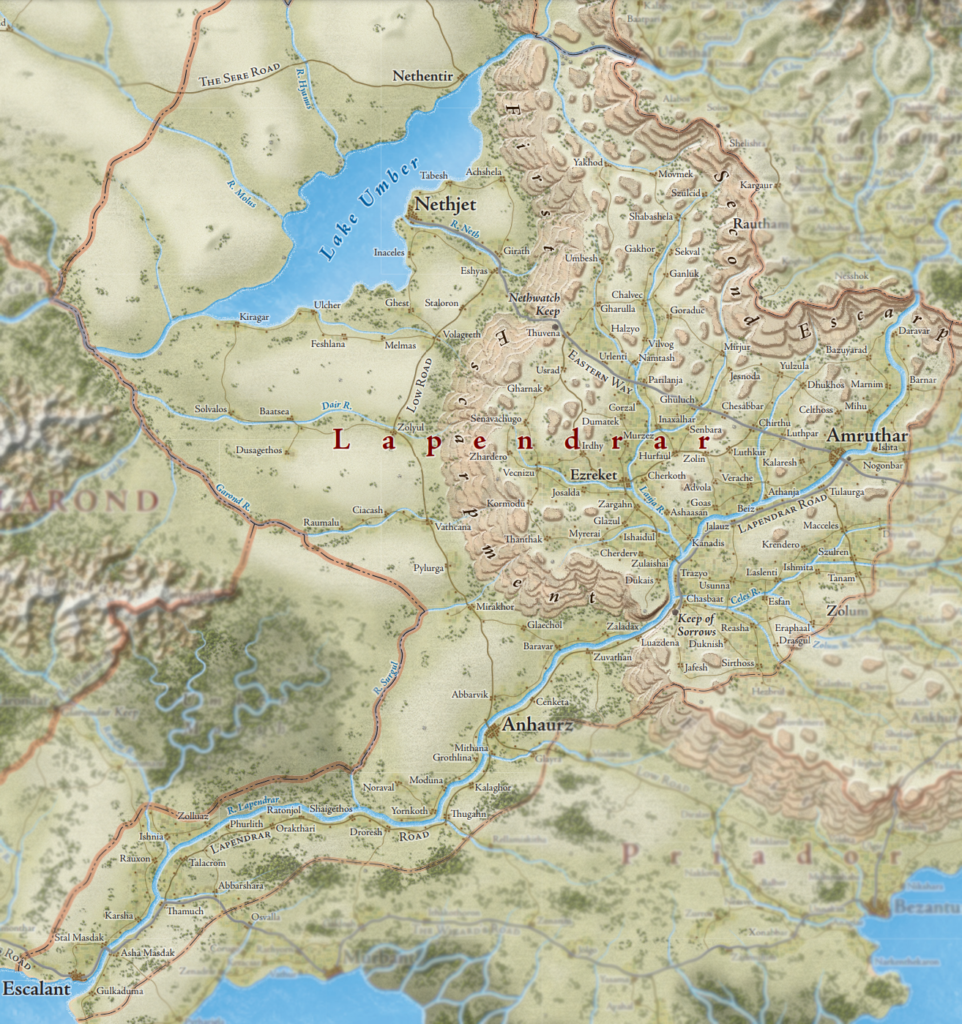
Laprendar has always been a popular destination for visiting outlanders. Its cities of Nethentir and Nethjet have always been centers of covert hostility to the Red Wizards and any authoritative rule from elsewhere in Thay. Szass Tam and the Zulkirs know this, but have decided to rely on the Probity Corps’ spies, covert assassins, and other agents of quiet warfare rather than to clamp down with military patrols or direct actions by the Red Wizards. Nonetheless, all senior Red Wizards know that “the Neth” (the folk of Nethentir and Nethjet) are a source of trouble with the ever-present promise of a brewing rebellion.
The eastern uplands of Lapendrar are ranchlands, open country, and small-hold farms. In recent years, Red Wizards have been ordered to work weather magic to provide enough dependable rainfall to keep the land from being parched. This has quelled much of the open mutterings against the red-robed mages or Tam’s rule; most citizens in this Tharch are fairly content because they feel they’re largely being left alone and ignored by the mighty of Thay right now—and that’s the way they like things.
The city of Nethentir has always supported a thriving cluster of rival live theaters. The locals have 39 a significant appetite for for tragedies and comedies, and especially savor sharp satires of Red Wizards and Thayan nobles. The rival city of Nethjet has always been a center of innovation and mechanization. The city’s residents have a love of assembly line processes and the creation of jigs and forms to assist with repeatable tasks.
Priador (“PREE-ah-door”)
Population: 396,500
Leader: Olone Dieyamron
Official Military Presence: The Water Fist, Thayan Knights
Commerce: Cash crops; Local retail
Religious Influences: Valkur, Umberlee, Waukeen

Priador is the most-recently founded Tharch and is just over a century old. Originally consisting of just the city of Bezantur, the region was eventually expanded to encompass the surrounding coastal area as well. The Tharch is now largely comprised of low-lying, cool-climate grassland rolling plains, verdant and green. Vegetation of all types flourishes here and has given rise to the Thayan saying “Things grow with the blessings of all the gods in the Priador.” This combined with three thriving port cities, Bezantur, Murbant, and Thasselen, collectively called by some sailors of other lands “the Jewels of Thay,” has made Priador perennially one of the most prosperous parts of Thay.
The brightest of the Jewels of Thay has always been Bezantur, known throughout Thay as “the heart of Thay” because it is where fashions are often set, where before the rise of the Red Wizards the nobility met to make pacts and decide policies, where in older times the largest slave markets were located, and where the makers of early Thayan culture were centered. Many bards and traveling merchant tale-tellers are also swift to point out that Bezantur is a place where any vice or depravity one can imagine can still be indulged in “given the appropriate loosening of both morals and purse strings.” It was also the center of early Thayan religion, which earned it the title of “the City of a Thousand Temples.”
The city of Murbant is surrounded by the largest Red Wizard estates, and has been called “the home of smugglers, traffickers of all types, and reeking fisherfolk,” a dismissive reputation that has stuck. Most Thayans of every Tharch save perhaps Gauros like to look down on Murbant, the “Tainted Jewel.”
Thasselen’s main site of interest to outlanders is Galauntowers, a mansion made over into six luxurious suites, but now abandoned thanks to a deadly spell-duel involving multiple mages.
Pyarados (“PIE-arr-AH-dose”)
Population: 84,000
Leader: Ortraun Naumarkh
Official Military Presence: The Probity Corps, Thayan Knights
Commerce: Caravan traffic, cash crops, metallurgy
Religious Influences: Waukeen
This Tharch is full of rolling hills that are patrolled lightly from the city at its heart for which the entire region is named. Pyarados the city is what it has been from the start: two distinct cities, one a slowly-growing ring around the other. As it has been for centuries, the city remains sharply divided. The seat of power and local governance is the interior city, with tall, reinforced walls; it is clean, ordered, and luxurious, with wide avenues bordered by manicured parks that sprawl everywhere. The grounds of noble homes and Red Wizards’ mansions maintain aggressively respectful separation so that no great house is close to another. Every such home has its stables, and lanes, and orchard-lined gardens and bowers, usually with fountain-fed pools. They give way to a narrow ring of balconied tallhouses around the inner wall. The wealthy and well-to-do merchants live in this crowded splendor as houses are scarce, fiercely sought-after, with most being purchased or otherwise appropriated by the nobles and Red Wizards immediately. In all, some four thousand souls dwell in “the Bright Heart.”
Most farms in this Tharch are in its westernmost lands, and are owned by the realm rather than a farmer or landholder; the farmers pay annual rents to work them. This outer ring of Pyarados is the Grimshield (just “Shield” in daily local speech) and is a dirty, crowded slum of unpaved, muddy winding alleys, ramshackle buildings that often collapse or lean groaningly against neighboring buildings, and lawless, grinding poverty. Many children behave as urchins, some rightfully so, and seek anything of value they can use, trade, or sell. Gangs roam the streets in the dark hours, battling each other for supremacy and a chance to raid any outlander goods left too lightly guarded. Justice in the Shield is still a matter of cudgels and swords, on the streets, not trials; trials are for the people of the Bright Heart and are rare even there, where quiet backroom deals settle most disputes, and the autarch, Ularth Haeraundor, exiles many unless overridden by the tharchion. Roughly sixty thousand folk dwell in the Shield, but no one properly counts “dirty Shielders” because to be counted is to be taxed, so the autarch really only knows the approximate count of how many building owners and official renters live in the outer part of his city.
Some interesting sites in this tharch are Redfist Tower and Laumauntor’s in the city, and the abandoned, reportedly haunted smelter of Hurrkeep, in the foothills a day northeast of the city.
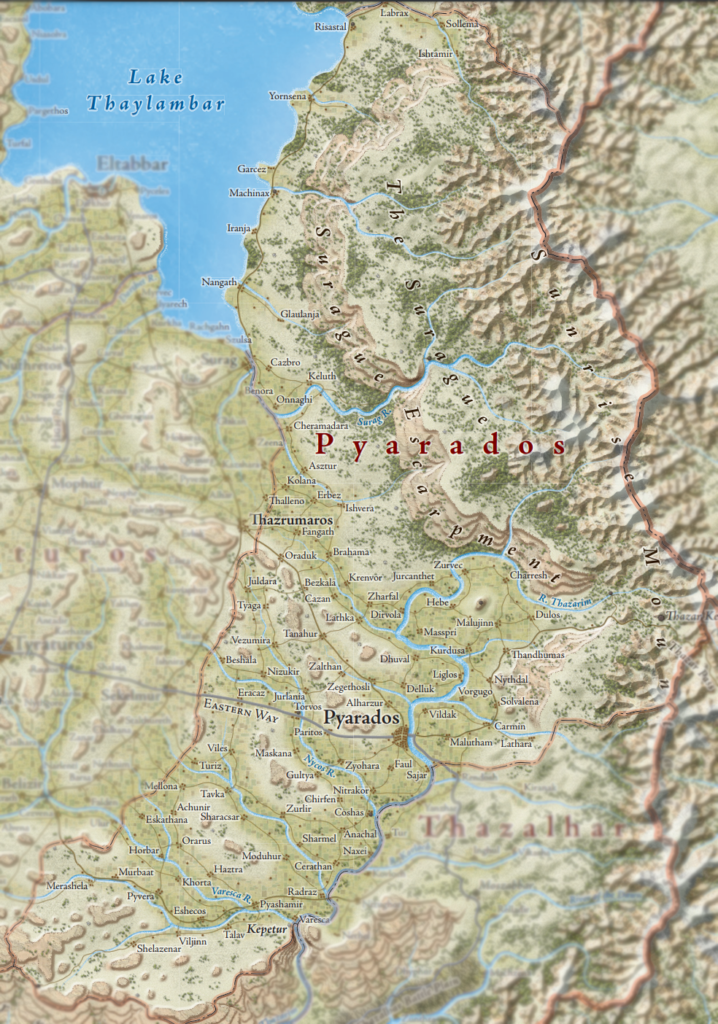
Surthay (“SUR-thay”)
Population: 62,000
Leader: Azaelra Odesseiron
Official Military Presence: The Water Fist, Corps of Thayan Knights
Commerce: Caravan traffic, fishing,
subsistence farming
Religious Influences: Helm, Malar, Tempus
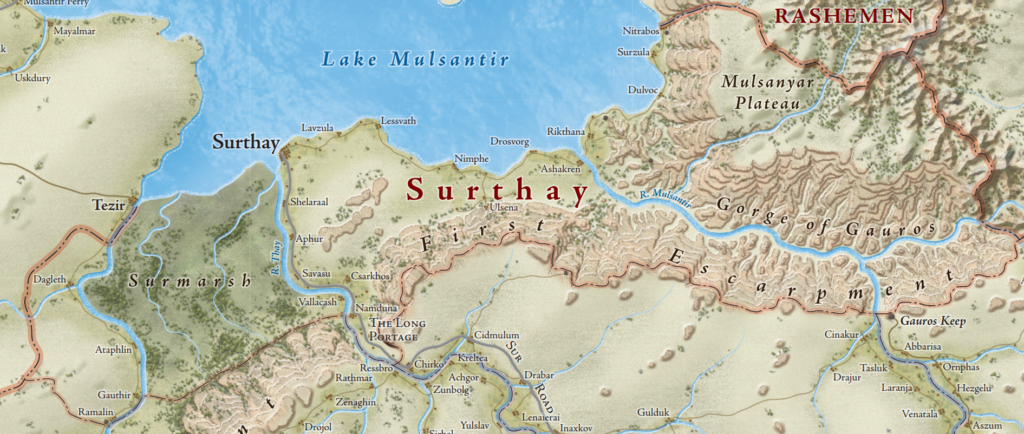
This Tharch, a strip of poor-soil hill country between the northern edge of the Plateau and Lake Mulsantir, has always been Thay’s military “wall of ready spells and swords” against its longtime foe, Rashemen. A “heavily-patrolled waste” was how one visiting merchant accurately described this region, and although this description is more than a few decades old, not much has changed. The frequent patrols find their base in the remains the fortified city of Surthay itself, a walled settlement that grew around the original castle of Surthay.
The city of Surthay today consists of three very different parts: “Westsulkh,” a dirty, crime-ridden shantytown that’s home to fisherfolk, poor Thayans who’ve fetched up here because they could find no better place to live in the rest of Thay, and a few outlanders who fled from justice or feuds or debts elsewhere; the frowning, mighty, many-towered fortress of Surtowers rising like the brutal stone prow of a huge ship in the center, pointed north at Rashemen and bristling with catapults, trebuchets, and ballistae; and “True Surthay” to the east, a district title self-bestowed by local Mulan nobles who dwell in a luxurious maze of walled mansions and the two-comfortable-coach-width lanes that curve between them. Among the nobles dwell the local Red Wizards of Surthay, with many of them being skilled abjurers.
Unfortunately, the Tharch does not produce enough food to feed itself, and its citizens live rather hapless lives. The tharchioness tends to personally kill any who dare to commit any sorts of casual murder or torturous acts in her Tharch, so most crime is of the “snatch goods and beat those who object” variety. Aside from the notorious Surmarsh, sites of interest in this tharch include the Lost Spires and Duskur’s Cave.
Thaymount
Population: 21,000
Leader: Eldroun Myrantar
Official Military Presence: The Probity Corps, Thayan Knights
Commerce: Mining, local retail, general exports
Religious Influences: Myrkul, Bhaal, Shar, Oghma, Velsharoon, Mystra
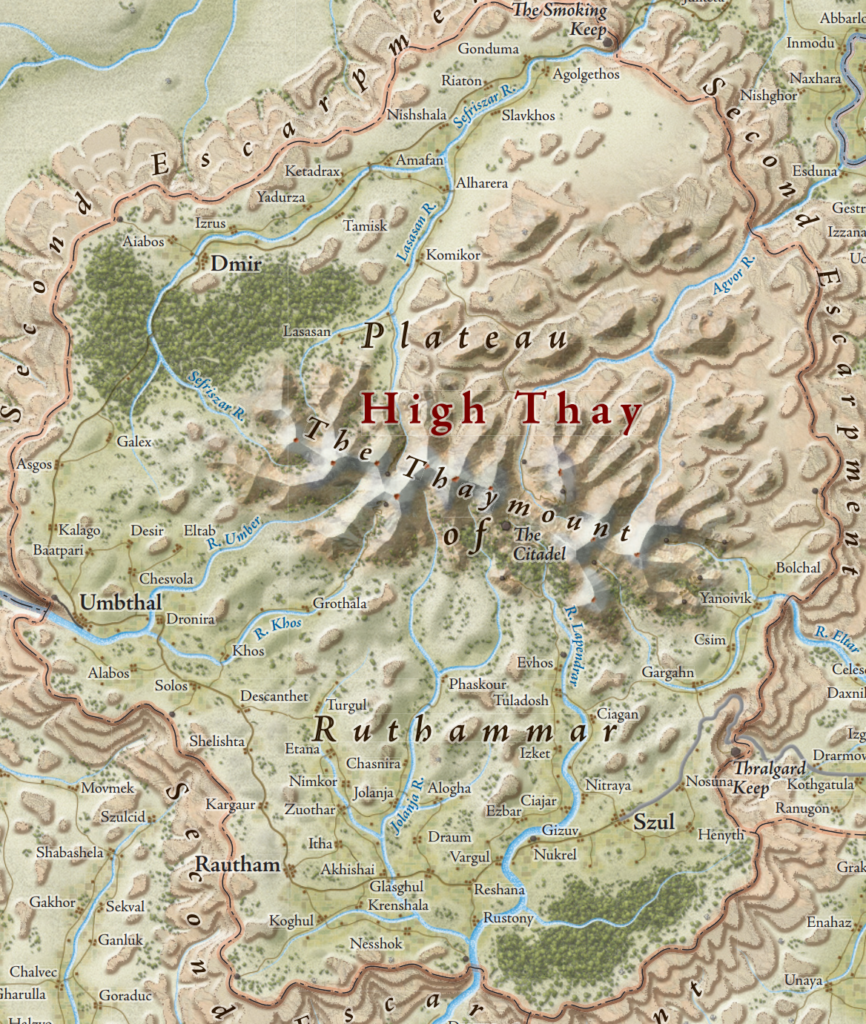
The highest-elevation Tharch in the realm, Thaymount consists of the Ruthammar Plateau and a range of volcanic mountains that rise up from it; collectively, they are referred to as “the Thaymount” or “High Thay” when speaking of the entire, larger region.
This region was rapidly transformed after Szass Tam chose to dwell and rule from here. Szass Tam’s presence meant that the Zulkirs of the realm soon maintained residences in Thaymount and spent most of their time there. So too did the most ambitious and powerful Red Wizards beneath the zulkirs, for fear of being sidelined, demoted, or simply ignored. This in turn attracted lesser Red Wizards, noble families, and even the wealthiest priests of Thay, all of whom established estates in High Thay, transforming the barren foothills of the mountains into terraced gardens around palatial mansions.
Weather throughout this Tharch is strictly controlled by weather spells worked by the Red Wizards; they keep everything well-watered, but restrict almost all rainfall to nighttime, to discourage illicit activities and to keep the daylit hours dry for the enjoyment of, and full use by, Thay’s wealthy and powerful.
Szass Tam rules from the Citadel, located within one of the highest peaks of Thaymount, slightly south of the midpoint of the range. The Citadel is an ancient stronghold of tunnels and subterranean chambers, encircling the caldera of an extinct volcano. These subterranean spaces have been much enlarged by Szass Tam—sometimes unintentionally, when spells he was experimenting with in deep caverns went awry, blowing apart huge areas of bedrock. The Citadel is now Szass Tam’s “ruling castle” even though it lacks towers and magnificent chambers of state, and its defenses are almost entirely the undead that crowd it.
Passages descend from the deepest halls of the Citadel in two directions: north under the mountain range to the Doomvault, and south to a gigantic cavern that thrums with crackling blue fire, and houses a floating rock of immense size that is rumored to be larger than many fortresses. This floating rock is the greatest secret of Thay: the Athora, a rock that also happens to be a mighty node of magic, a source of magical energies so strong and restless that it has made the mountain, and much of the plateau around it, radiate strong magic
Thazalhar (“THAZ-all-har”)
Population: 14,000
Leader: Yaelend Hulthroun
Official Military Presence: Thayan Knights
Commerce: Caravan traffic, sporadic inns, subsistence farming
Religious Influences: Malar, Ilmater, Shar
The southernmost Tharch of Thay, Thazalhar is essentially a border defense region. It is hilly countryside, patrolled by mounted soldiers as commanded by Yaelend Hulthroun, the tharchion. It has no cities and no named settlements on maps, and its population consists of a handful of roving shepherds and their flocks, a larger handful of innkeepers and horse- and oxen-traders located in individual steadings along the trade roads.
Due to its devastation in the Battle of Thazalhar when the demon Eltab was summoned, most of Thay believes this Tharch is haunted; after the fighting was done, this Tharch was described as “one vast graveyard.” Many Thayan tales tell of “armies of the restless dead” rising out of the soil to march by night, overwhelming isolated homes and even inns, and terrorizing the living who do manage to flee.
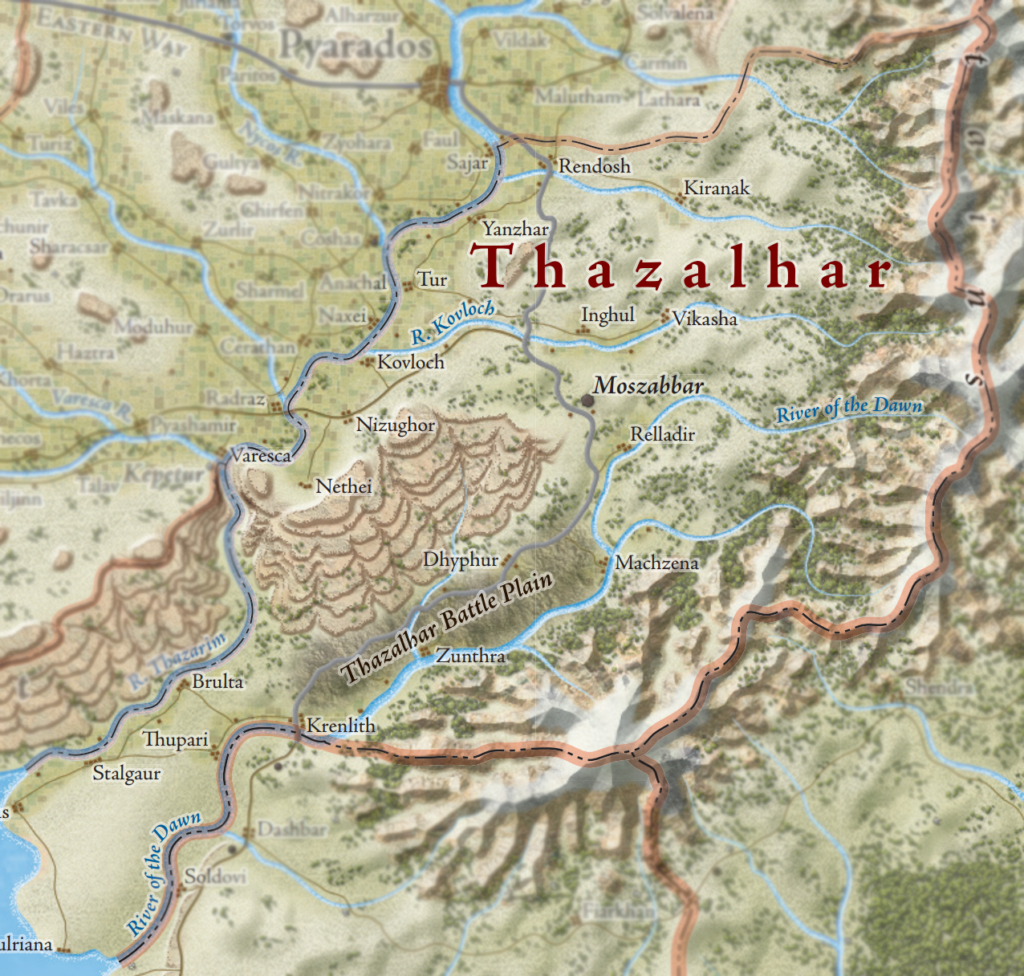
Tyraturos (“Tie-Rah-Tor-Ohs”)
Population: 2,770,000
Leader: Elveirhyadra Haundor
Official Military Presence: The Probity Corps, Thayan Knights
Commerce: Exports including various cash crops, spirits, and finished goods; retail sales; destination travel; banking
Religious Influences: Chauntea, Oghma, Mask, Waukeen, Amaunator, Shiallia
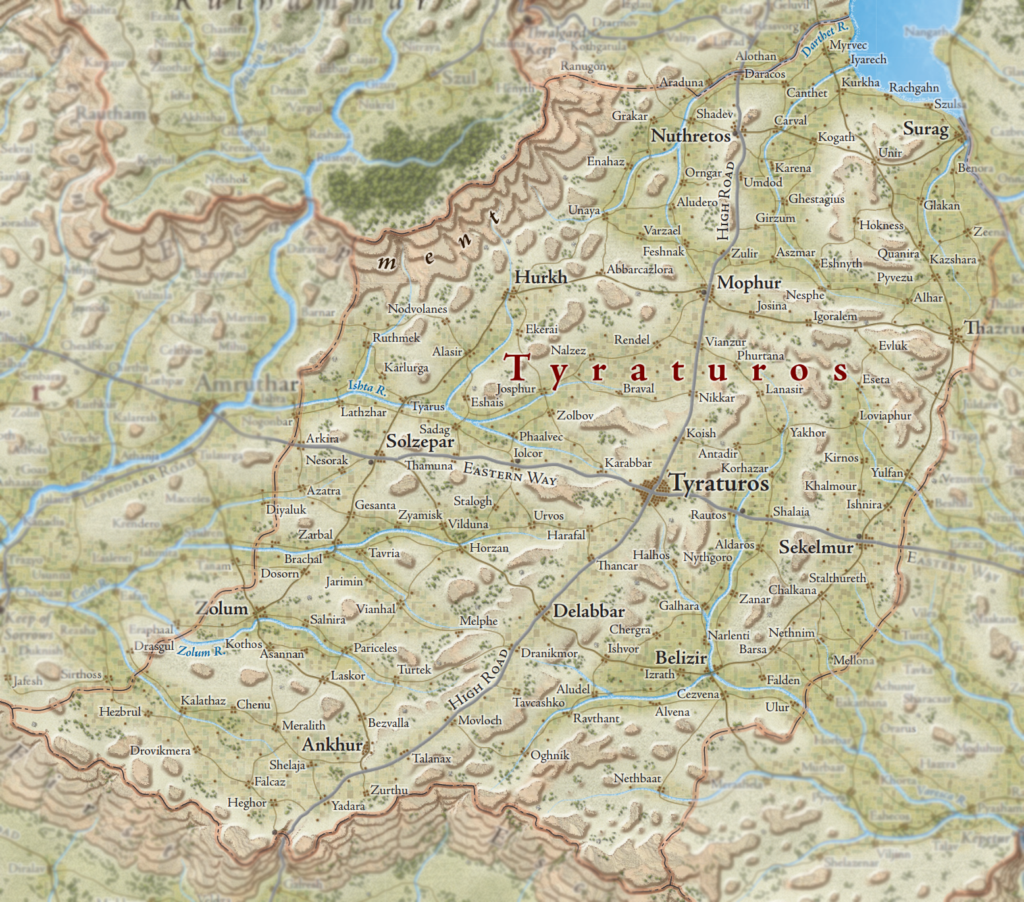
To all Thayans who aren’t Zulkirs, nobles, or powerful Red Wizards, this Tharch is the heart, backbone, and “big belly” of Thay. Tyraturos annually produces many vegetable crops and copious amounts of fruit in its southern reaches, and is especially known for grain crops that are made into bread, ale, and stronger fiery drinks like bazaedur. Bazaedur is a sweet, jet-black syrupy vintage, beloved by many Thayans but is an acquired taste for most drinkers from other lands.
Wagons creak and groan through this Tharch day and night, and its toll booths—as its tax stations are known—are populated day and night. An empty wagon may pass for free, but a laden one must pay one silver piece. Thanks to these regular tolls and the bountiful crops, Tyraturos is quite prosperous, and its current tharchioness makes sure that wealth reaches even the lowliest of residents.
The city of Tyraturos was once notorious as a filthy, unpleasant place, but under its last three autarchs and the current tharchioness and her predecessor, sewers have been constructed, roads re-laid, and many buildings razed and replaced. Moreover, a highly trained and professional city watch has been founded and trained; they are paid well.
Szass Tam not-so-subtly let it be known that the rebuilding city would no longer be a political battleground and feuding Zulkirs or nobles were to relocate their disputes to elsewhere in Thay and treat this city as neutral ground—or else. It only took about a dozen unpleasant public demises before his message was accepted, and the new social whirl captured the support of most of the local antagonists; those who could not or would not bend withdrew from social life in the city, and everyone else tried to be nice to each other and soon—on the surface, at least—succeeded. Now, the “Peace of Tyraturos” is something most citizens, high and low, prize and fight to maintain. And as a result, trade and commerce has soared, fortunes are being made, taxes are being paid almost joyfully, and “all banners are rising.”
Places of interest include the Hall of Masks, the Loom of Many, and the Ring of Wizards.